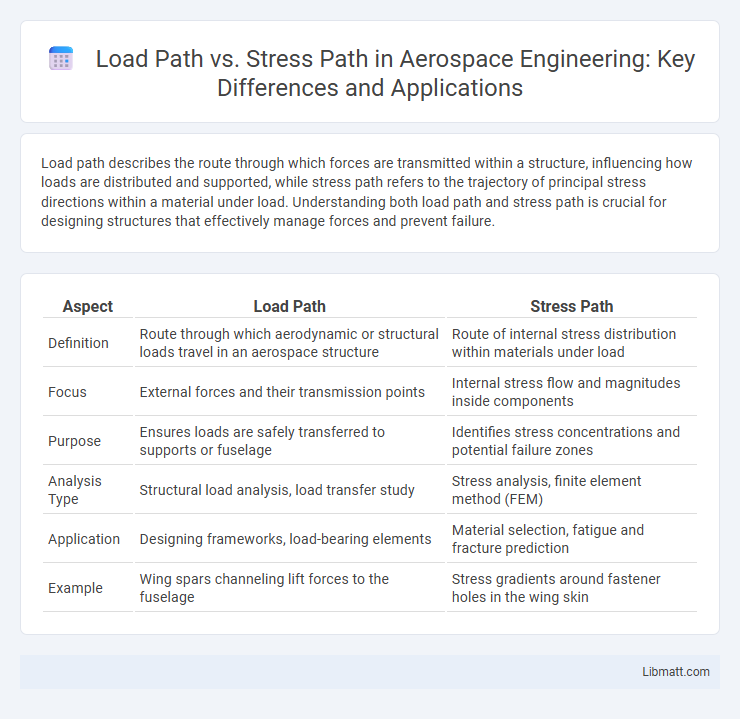Load path describes the route through which forces are transmitted within a structure, influencing how loads are distributed and supported, while stress path refers to the trajectory of principal stress directions within a material under load. Understanding both load path and stress path is crucial for designing structures that effectively manage forces and prevent failure.
Table of Comparison
| Aspect | Load Path | Stress Path |
|---|---|---|
| Definition | Route through which aerodynamic or structural loads travel in an aerospace structure | Route of internal stress distribution within materials under load |
| Focus | External forces and their transmission points | Internal stress flow and magnitudes inside components |
| Purpose | Ensures loads are safely transferred to supports or fuselage | Identifies stress concentrations and potential failure zones |
| Analysis Type | Structural load analysis, load transfer study | Stress analysis, finite element method (FEM) |
| Application | Designing frameworks, load-bearing elements | Material selection, fatigue and fracture prediction |
| Example | Wing spars channeling lift forces to the fuselage | Stress gradients around fastener holes in the wing skin |
Introduction to Load Path and Stress Path
Load path defines the sequence of forces and moments transmitted through a structure, while stress path describes the evolution of stress states within a material under loading. Understanding load paths helps you design structures that efficiently transfer forces to supports, ensuring stability. Stress paths provide insight into material behavior and failure mechanisms, crucial for accurate stress analysis and safety assessments.
Defining Load Path in Structural Engineering
Load path in structural engineering refers to the trajectory through which applied forces travel within a structure from the point of application to the foundation or ground. Understanding load paths enables engineers to design structures that effectively transfer stresses and prevent failure by directing forces through members with adequate strength. Your ability to identify and optimize load paths ensures structural integrity and safety under various load conditions.
What is a Stress Path?
A stress path represents the trajectory of stress changes within a material or soil element during loading, showing how principal stresses evolve with respect to each other. Unlike the load path, which depicts external forces applied over time, the stress path focuses on internal stress states that influence deformation and failure behavior. Understanding your system's stress path is essential for predicting material response and ensuring structural stability under varying load conditions.
Key Differences Between Load Path and Stress Path
Load path refers to the trajectory along which external forces are transmitted through a structure or material, while stress path describes the variation and distribution of internal stresses within the material under loading conditions. Load path analysis helps identify critical points where loads concentrate, essential for structural design and safety assessment. Stress path focuses on changes in stress states, crucial for understanding material behavior, failure mechanisms, and deformation under complex loading scenarios.
Importance of Load Path Analysis
Load path analysis plays a crucial role in structural engineering by identifying the most efficient route for forces to travel through a structure, ensuring optimal distribution of stresses and preventing failure points. Understanding the load path helps in designing safer buildings and infrastructure by anticipating stress concentrations and improving material usage. Precise load path evaluation reduces the risk of unexpected structural weaknesses, enhancing both durability and performance under varying load conditions.
Role of Stress Path in Material Behavior
Stress path plays a critical role in determining material behavior by describing the evolution of principal stresses during loading and unloading cycles. Understanding the stress path allows you to predict failure modes, plastic deformation, and strain localization in materials such as soils, metals, and composites under complex loading conditions. Accurate analysis of the stress path enhances the design and safety assessment of structures by anticipating how materials respond under varying stress states.
Load Path Considerations in Building Design
Load path in building design defines the route that structural loads follow from the point of application to the foundation, ensuring proper transfer of forces such as dead loads, live loads, and environmental loads like wind and seismic forces. Stress path refers to the internal distribution and flow of stresses within structural elements, impacting material selection and cross-sectional design to prevent failure. Effective load path considerations enhance structural integrity, durability, and safety by ensuring that loads are efficiently transferred and stress concentrations are minimized throughout the building framework.
Stress Path Applications in Geotechnical Engineering
Stress path analysis plays a critical role in geotechnical engineering by tracking changes in soil stress states during loading, which informs the design of foundations, retaining structures, and slopes. This method helps predict soil behavior under various load conditions, ensuring stability and safety in construction projects. Engineers utilize stress path techniques to optimize soil improvement strategies and assess failure mechanisms in complex soil-structure interactions.
Common Mistakes in Interpreting Load and Stress Paths
Misinterpreting load path and stress path often leads to inaccurate analysis in structural engineering, especially when confusing external load direction with internal stress distribution. Assuming that the load path always aligns with the principal stress trajectory can cause design errors and potential failure risks. Understanding the nuanced differences is crucial for ensuring your structural assessments accurately predict component behavior under varying load conditions.
Summary: Choosing Between Load Path and Stress Path Analysis
Load path analysis traces the trajectory of applied forces through a structure, highlighting the route and magnitude of loads, while stress path analysis maps the evolution of internal stresses within materials under varying conditions. Selecting between load path and stress path analysis depends on the specific engineering objective: load path analysis is ideal for structural design optimization and failure prevention, whereas stress path analysis excels in material behavior prediction and plastic deformation studies. Engineers often integrate both methods to enhance structural integrity assessments and improve safety margins in complex systems.
load path vs stress path Infographic

 libmatt.com
libmatt.com